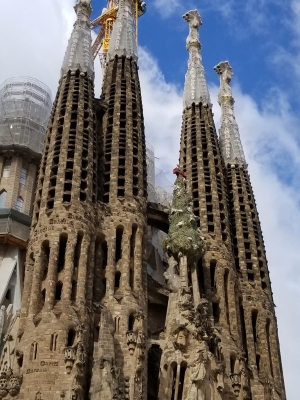A Spanish Sampler
What a difference a year makes. A year ago Judy and I traveled to Italy. It was our first trip together as a couple. The trip was not without its adjustments. Our approaches to travel, to accommodations, and to time itself were so different. This time we were determined to get it right.
Spain was our destination. Before the trip we made certain decisions. We would stay only in hotels, no more B and B's. We would hire personal guides at points of interest to avoid long lines. And we would be more understanding of each other's idiosyncrasies.
Madrid was our first stop. Carmen, our personal guide, regaled us with her conservative views of Spanish society as she took us on a walking tour of the city. "Let them secede from Spain," she said of the infuriating Catalonians. "Who needs them? They have no respect for our traditions."
"Of course," she continued, "there is no issue of cruelty to animals in bullfighting, only the courage of the matadors. And, oh, what gall of the newly elected communist mayor to introduce same sex stick figures holding hands at traffic crossings to show her support of the LGBTQ community."
"How could she say those things?" fumed Henrique, our ultra-liberal personal guide at the Prado Museum the next day. He presented his diametrically opposed points of view to us. It was the Spanish Civil War all over again but this time, thankfully, only a war of words.
From Madrid we flew to Barcelona. My first impression of the city was that it had been overrun by hordes of tourists from all over the world. But, gradually, I warmed to the city.
Antonio Gaudi is the famous Barcelona architect whose whimsical approach can be seen in buildings throughout the city. I had always thought of Gaudi as a contemporary, perhaps because there are a number of buildings on Hayarkon Sstreet in Tel Aviv built in his style. But, I was wrong. Actually, Gaudi died in 1926. This fact added a certain gravitas to his work for me.
When Gaudi received his degree from the Barcelona Architecture School, the director of the school quipped that he was either a genius or a madman and that time would tell which. Our visit to the Gaudi inspired Sacred Family Church on which he worked for forty years left me no doubt that he was a great visionary, a true original.
We flew to the south of Spain from Barcelona. Granada was our first stop. It is the home of the world famous Alhambra, a palace and fort built by the Moors in the 800's and taken over by the Christians in 1492. That was the year both the Jews and the Muslims were expelled from Spain.
Daniel, our guide at the Alhambra, pointed to a section of floor, now roped off to visitors. He explained that it was originally part of the Moorish palace wall and contained verses from the Koran with Allah's name.
The Christians removed the tiles from the wall and reset them
as a floor - this in order to humiliate the Muslims for whom treading on Allah's name is a mortal sin. What a shame that hundreds of years later this religious animosity between the two religions persists, albeit this time more from the Muslims towards the Christians.
We took a bus from Grenada Granada to Malaga. Judy had heard of a challenging three hour walk along the steep walls of a narrow gorge called Caminito del Rey, an hour's ride from the city.
Reopened in March last year as an attraction for the adventurous tourist, the walk was everything Judy hoped it would be - from the stunning scenery of rock formations to the sightings of vultures gliding high overhead to the views of green tinged streams 300 feet below.
I should have known that the walk was not for the fainthearted when our guide asked us if we suffered from vertigo. The fact that we didn't made our traversing the narrow swaying suspension bridges a bit less harrowing.
Our final destination was Seville. It is from this city that Christopher Columbus set sail for the new world. And it is in the city's Santa Maria Cathedral that he is buried. More exactly, where some of him is buried.
It is said that Columbus travelled more in death than he did in life. Without going into too many details Columbus was first buried in Spain, then reinterred in Santo Domingo in the Dominican Republic, then reinterred in Cuba, and finally reinterred in Spain again. But, not all his body made it.
In 2006 the Spanish government authorized a DNA test on the remains. Matching the results to those of his son it was conclusively confirmed that the body in the church is indeed his. Columbus is an honored figure in Spain and there are statues of him in many city centers. For Americans, though, he is an iconic figure and it was meaningful for us to pay him our respect at that place.
Our trip ended in Seville and we flew home to Chicago. There was so much more to our twelve days than what I have described - the joy of the Spanish way of life, the warm welcome we received wherever we went, and the wonderful food.
But these are things beyond my ability to describe. My recommendation is to experience the country for yourselves.









Comments